Last Updated on May 17, 2024 by
This is the complete Bukhara travel guide covering: best places to visit in Bukhara, best things to do in Bukhara Uzbekistan, including information on where to stay and the best restaurants in Bukhara.
Read on how the best way to explore Bukhara is to walk in the dense network of back streets that conceal many monuments.
Nestled along the ancient Silk Road, Bukhara, Uzbekistan is situated between two important cities – Samarkand and Khiva. With its narrow alleyways, well preserved mosques, and bustling bazaars, Bukhara is the quintessential residence of the former Emirs of Bukhara. Bukhara has a very European feel to it which is why it should be on your Uzbekistan Travel Itinerary. Know all about it here.
Table of Contents
HISTORY OF BUKHARA
Bukhara is a UNESCO World Heritage Centre. The Historic Centre of Bukhara, located along the Silk Roads, is over two thousand years old which stands as one of the best-preserved examples of Islamic cities in Central Asia from the 10th to 17th centuries. Despite the presence of a few significant remnants from before the Mongol invasions of Genghis Khan in 1220 and Temur in 1370, the old town primarily showcases the urbanism and architecture of the Shaybani period of Uzbek rule, beginning in the early 16th century.
In the 18th century, the Manghits seized control of the Khanate of Bukhara and established the Emirate of Bukhara. In the 19th century, the city came under Russian rule. Uzbekistan became part of the former USSR in 1924 and eventually gained its independence from the USSR in 1991.
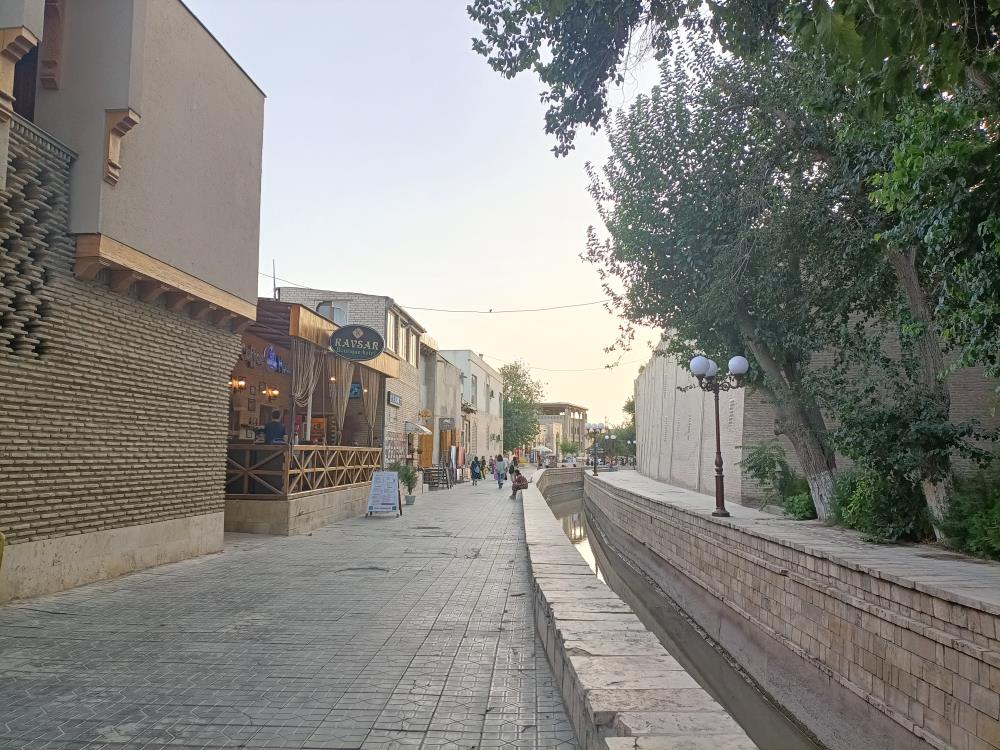
BUKHARA TRAVEL GUIDE : PRACTICAL TIPS
Getting to Bukhara
Bukhara is very well connected to Samarkand and Khiva and travelers stop by while going to either of these two cities. There are several trains each day from Tashkent towards Bukhara. They are fast, comfortable, and generally run-on schedule. The trip from Tashkent to Bukhara takes about 4 hours in Afrosiyob (bullet train) and 1.5 hours from Samarkand to Bukhara in Afrosiyob (bullet train). A regular train takes about 7 hours.
Getting around Bukhara
While most places are walking distance in Bukhara, if visitors chose an accommodation away from the city centre they will have to choose a short commute (10-15 min in cab).
Tourists can use local taxis or app-based taxis – YandexGo. Similar to Uber, it is widely used in Uzbekistan. This is really useful as you don’t have to haggle with the taxi drivers regarding the fares and confusion regarding the destination – the accent makes it difficult to understand. An average taxi ride from anywhere in Bukhara is approximately 12,000 – 20,000 UZS ($1 – 1.6).
Hotels in Bukhara
Diyor Hostel
Located in Bukhara, there is a garden, shared lounge, terrace and free WiFi. They also offer continental breakfast. The property can be booked here.
Grand Ark Hotel
I stayed here for 2 nights exploring the Bukhara. It is an idyllic property with very comfortable rooms. Grand Ark Bukhara features a seasonal outdoor swimming pool, terrace, restaurant, and free WiFi throughout the property.
At the hotel, the rooms come with a wardrobe. Each room comes with air conditioning, a desk and a flat-screen TV, and certain rooms at Grand Ark Bukhara have a balcony.
The property can be booked here.
Lyabi House Hotel
I went to their in-house restaurant and promised myself to stay the next time! I highly recommend one meal at the Avyan Restaurant – the aesthetics are so well done!
Located in the historic centre of Bukhara, Lyabi House Hotel is set in a 19th-century building decorated with antique furnishings. With free Wi-Fi access, the air-conditioned rooms all come with a refrigerator, a work desk and a TV. Each has a private bathroom equipped with a bathtub, free toiletries and a hairdryer.
The restaurant offers Uzbek cuisine, which is served on the terrace in warm months. Breakfast is available daily.
Lyabi House Hotel can be booked here.
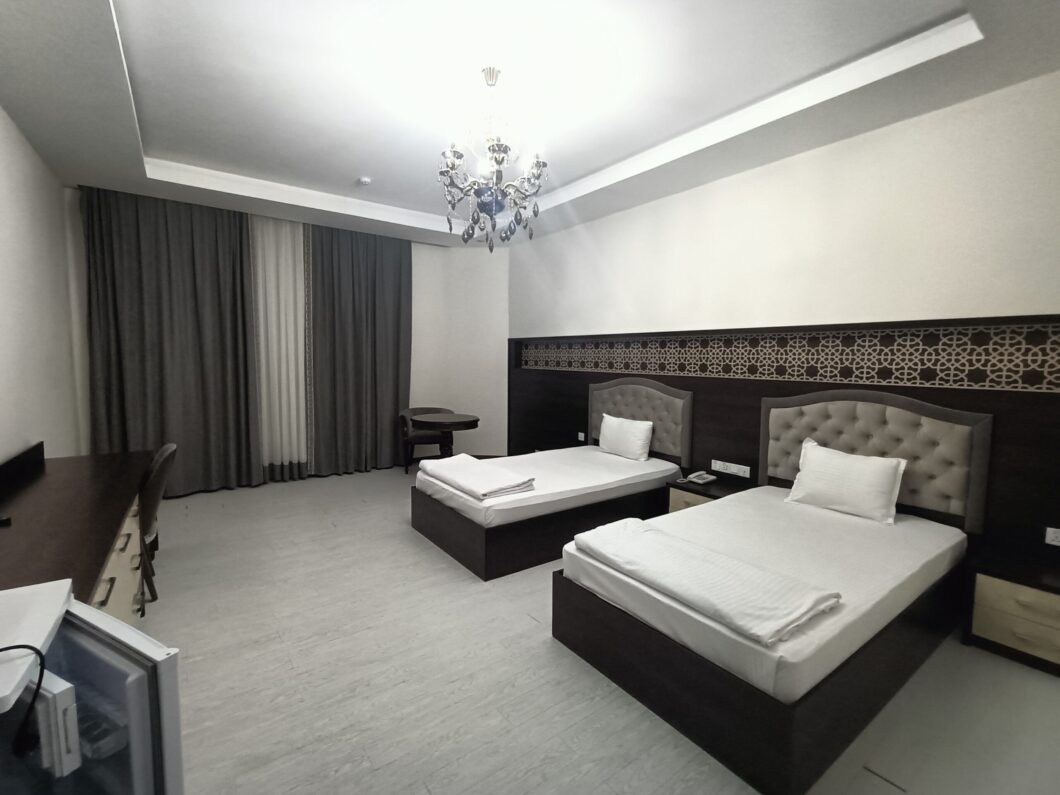
Where to eat in Bukhara
Being a vegetarian, I was quite worried about getting vegetarian food in Uzbekistan. Thankfully, Bukhara has vegetarian food options across the city.
These are some of the vegetarian restaurants in Bukhara that I tried and liked.
Chalet
A beautiful cafe surrounded by greenery, Chalet is hard to miss as it is located at the beginning of Mekhtar Anbar street. It has an Italian restaurant offering a variety of vegetarian and vegan dishes.
Address: Mekhtar Anbar Str, Bukhara, Uzbekistan
Bella Italia
Another Italian restaurant with a wide variety of vegetarian dishes and a few vegan dishes. Pizza, pasta, salads and soups are clearly marked vegetarian and are delicious. The staff speak English.
Address: Bakhovaddin Nakshband 125, Bukhara, Uzbekistan
Ayvan
Aesthetically beautiful, Ayvan was on the top list of places to eat in Bukhara. The restaurant is located inside Lyabi House hotel, an upscale property in Old Bukhara.
Ayvan has a fantastic selection of alcohol, vegetarian as well as vegan options. The staff has an English speaking waiter and they recommend food based on your likes. There is an outdoor as well as indoor sitting area.
Address: N. Husainova #7 (at Lyabi House), Bukhara
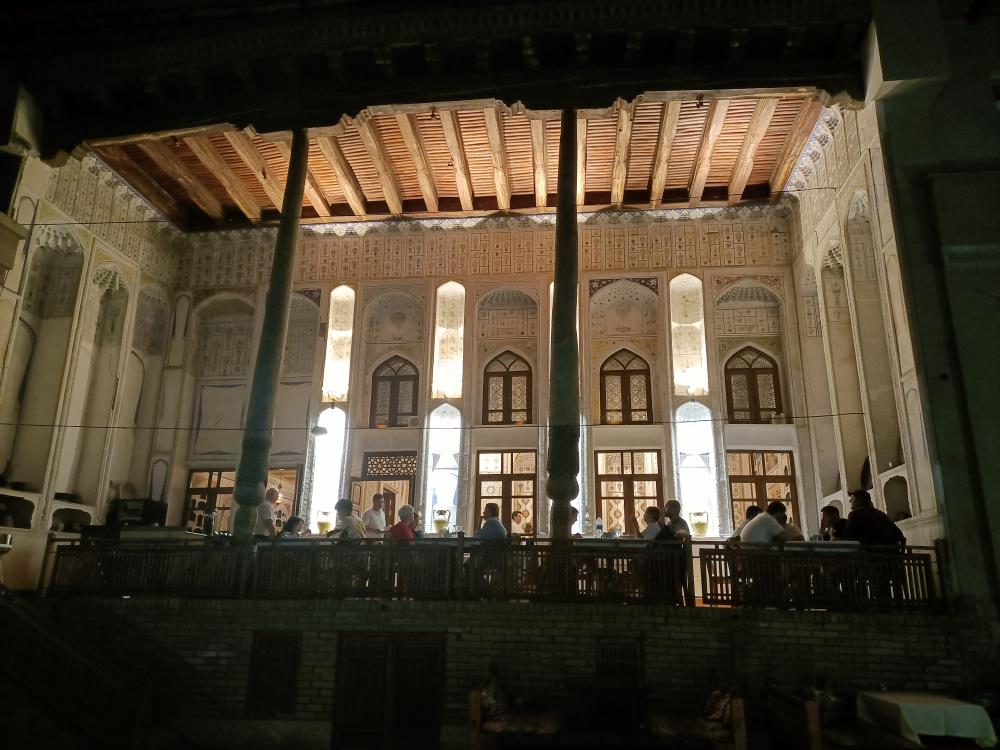
2 DAYS BUKHARA ITINERARY
I took the 9:00 pm Afrosiyob from Samarkand and reached Bukhara at 10:30 pm. I booked a Yandex Go and checked-in to my hotel. I had 2 days to explore Bukhara.
My hotel was a little far from the city centre so I had to rely on a taxi. Since it was very hot in the afternoon, I went out after breakfast and came back around 2 pm. Hailed a taxi again around 5pm after a little rest and nap.
Day 1:
Po-i-Kalyan Complex (Kalyan Mosque, Kalyan Minaret, Mir-i-Arab Madrasa)
Ark of Bukhara
Bukhara Tower
Bolo Hauz Mosque
Chor Minor
Central Bazaar
Day 2:
Bozori Kord Bathhouse
Bukhara Photo Gallery
Lyab-i-Khauz
Madrasah Nadir Devon Begi (at Lyab-I-Hauz Ensemble)
Hosja Nasruddin Statue
Ulugbek Madrassah
Abdulaziz Khan Madrassah
BEST THINGS TO DO IN BUKHARA
Po-i-Kalyan Complex
One of the top attractions in Bukhara is the Po-i-Kalyan complex, the main square of the city.
Upon arriving at the square, you will see the Kalyan Mosque on your right, the Kalyan Minaret straight ahead, and the Mir-i-Arab Madrasah on your left. The Kalyan Minaret, built in 1127 AD, stands about 47 meters tall and dominates the center of the old city. Its name means “great,” and it was so impressive that Genghis Khan chose to spare it when he conquered Bukhara.
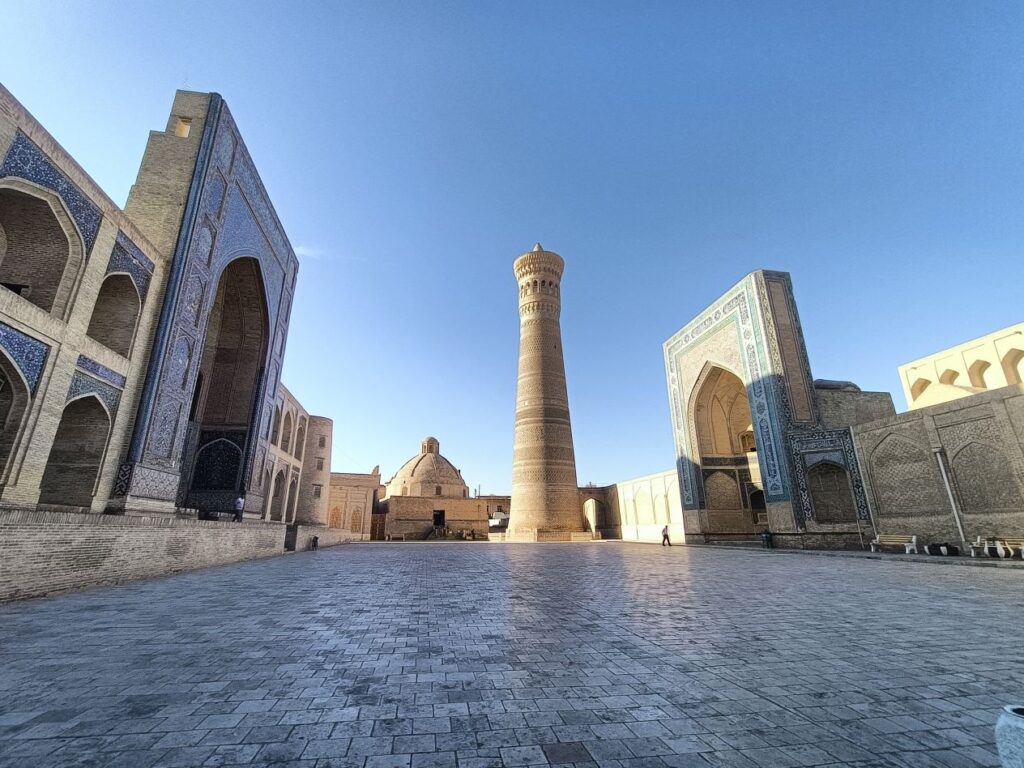
The Kalyan minaret is lit up in the evening after sunset and I would highly recommend you to revisit the square at night. It looks absolutely beautiful.
The Kalyan Mosque, located next to the minaret, is the largest mosque in Bukhara. It is particularly stunning to visit early in the morning, especially at sunrise. If you arrive before the official opening time, you can enter the mosque for free; otherwise, there is an entrance fee of 20,000 som.
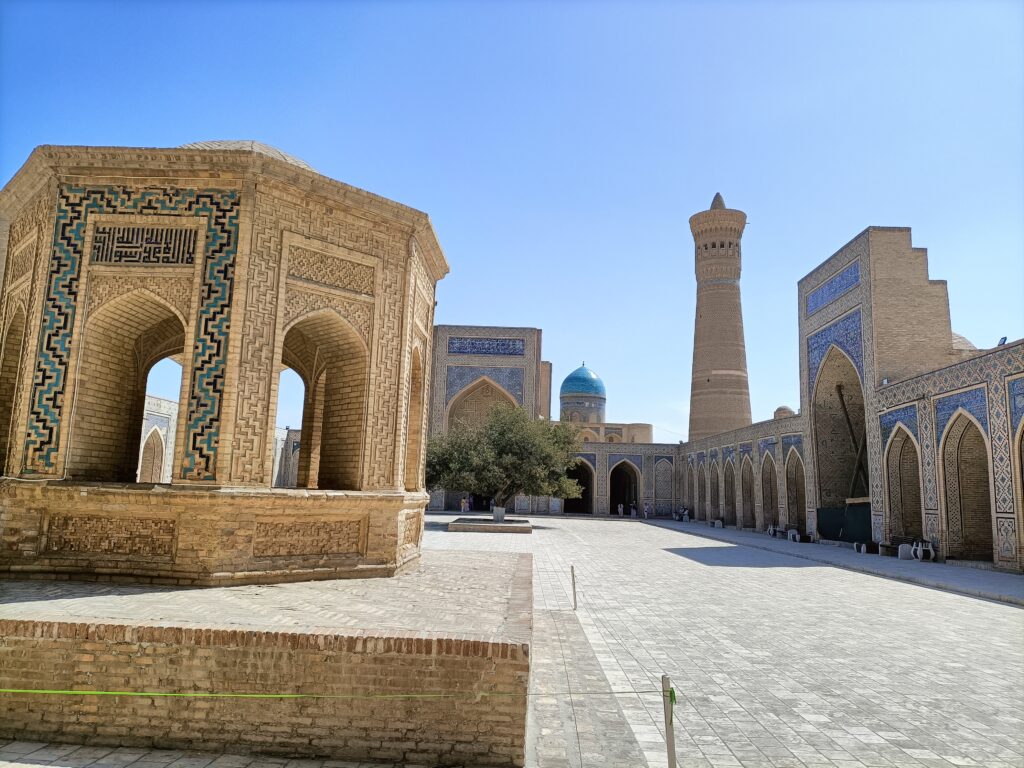
Capturing the Kalyan Minaret from various angles is a great way to explore the lanes and bylanes. I went there 4 times in different times of the day and got beautiful shots.
Po-i-Kalyan timings: 9 am to 8 pm
Po-i-Kalyan entrance fees: 20,000 som (US$1.5)
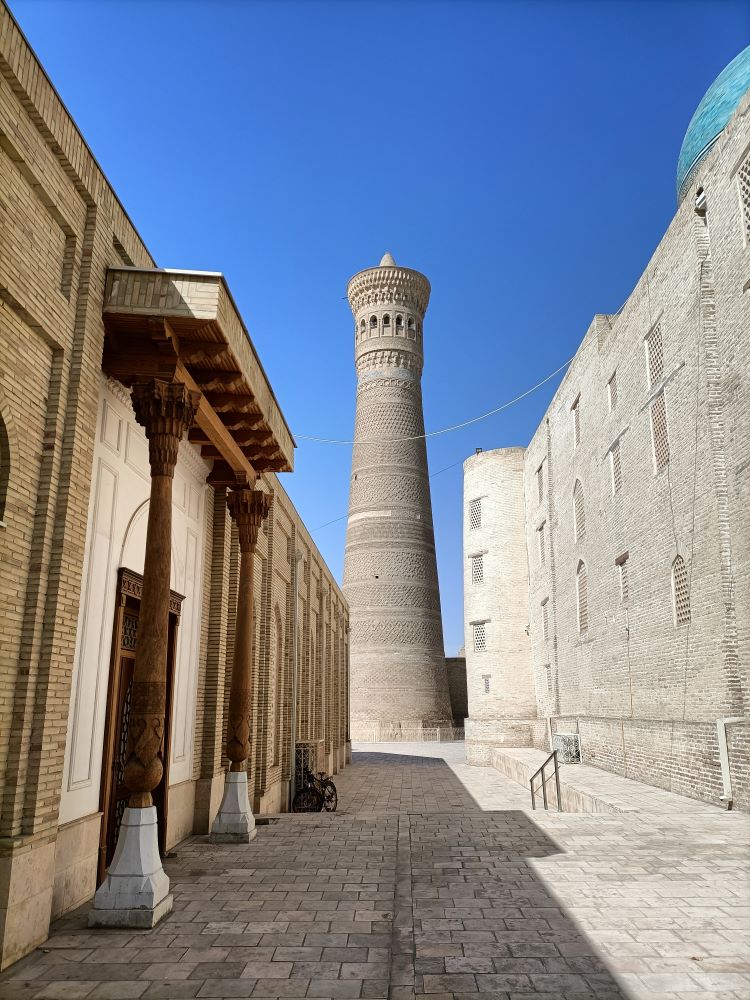
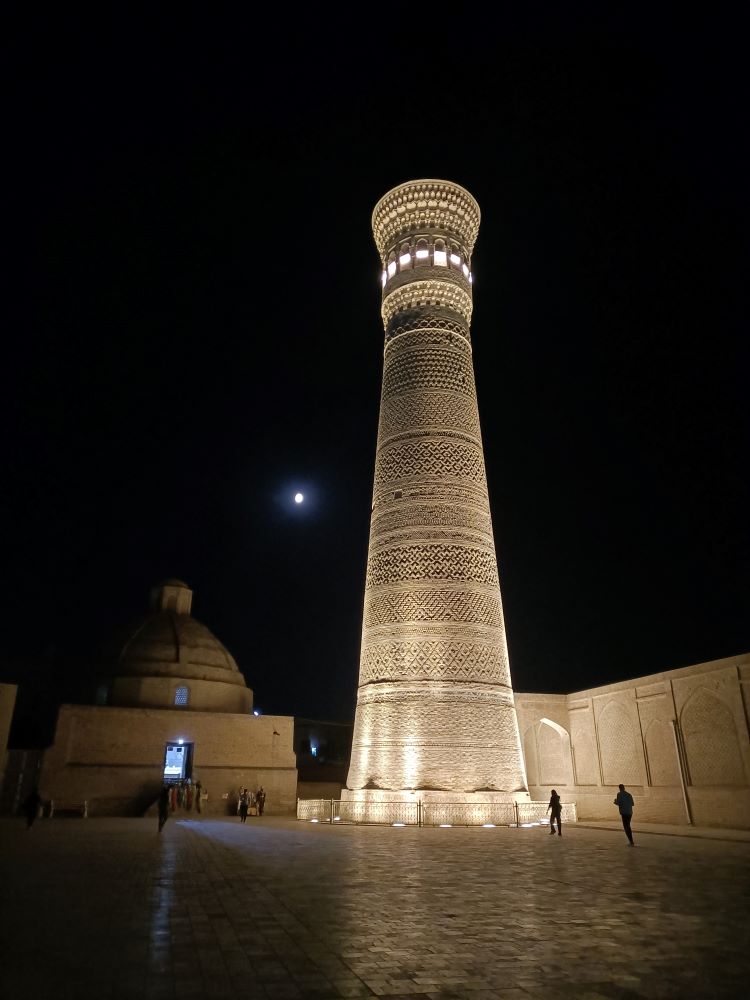
Ark of Bukhara
One of the best things to do in Bukhara is visiting the Ark of Bukhara. The Ark, is a huge earthen-walled citadel, dating back to the 4th century, covering an area of roughly two hectares. This structure was a residence for the ruling Khans, but it has been converted into a museum.
The word Ark is actually taken from the Persian word Arg, which refers to a castle or citadel. The Ark, one of Bukhara’s oldest structures, encompasses several museums, a mosque, and old stables. Having a guide or an audio guide is a great way to explore this huge citadel.
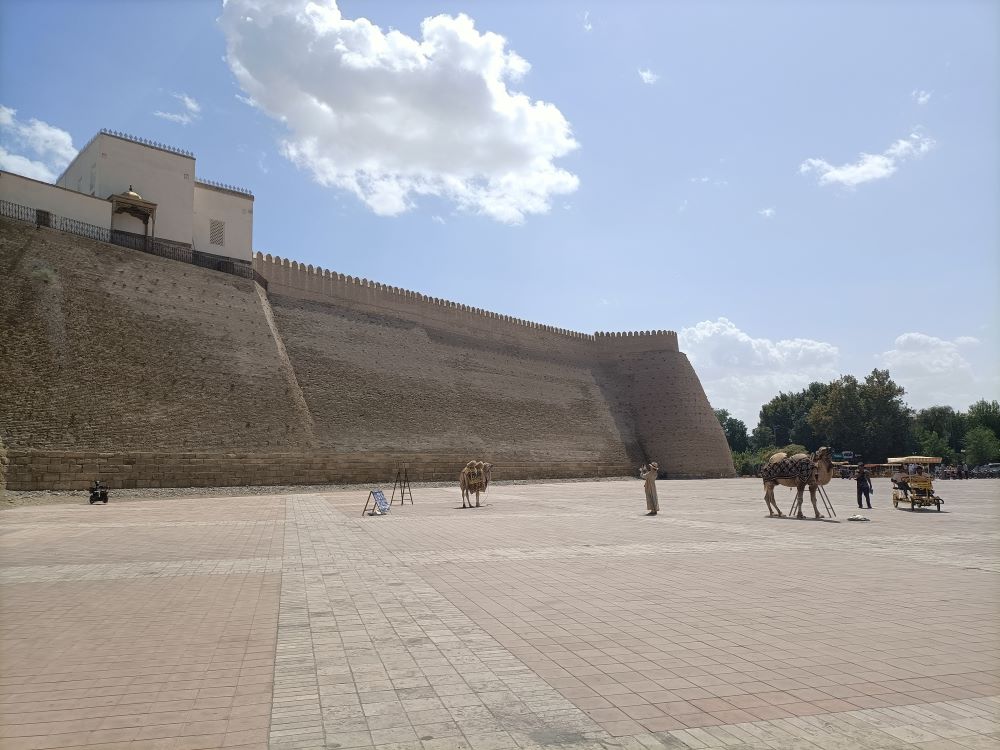
This white citadel, once a military fort and a symbol of state power, has stood as the gateway to Bukhara’s old city since the 5th century AD. It functioned as a fortress until the early 1920s. Over the centuries, the massive citadel has been destroyed and rebuilt multiple times. Legend has it that the Emir himself blew up the palace to prevent it from falling into enemy hands.
Exploring the fortress in the early evening is a great activity, especially as the sun sets. From the top of the walls, you can enjoy a beautiful view of the western part of the city and Samanidov Park bathed in the last rays of sunlight.
Ark of Bukhara timings: 9 am until 8 pm
Ark of Bukhara entrance fee: 40,000 som (US$ 3.5). Audio guides available at 20,000 som.
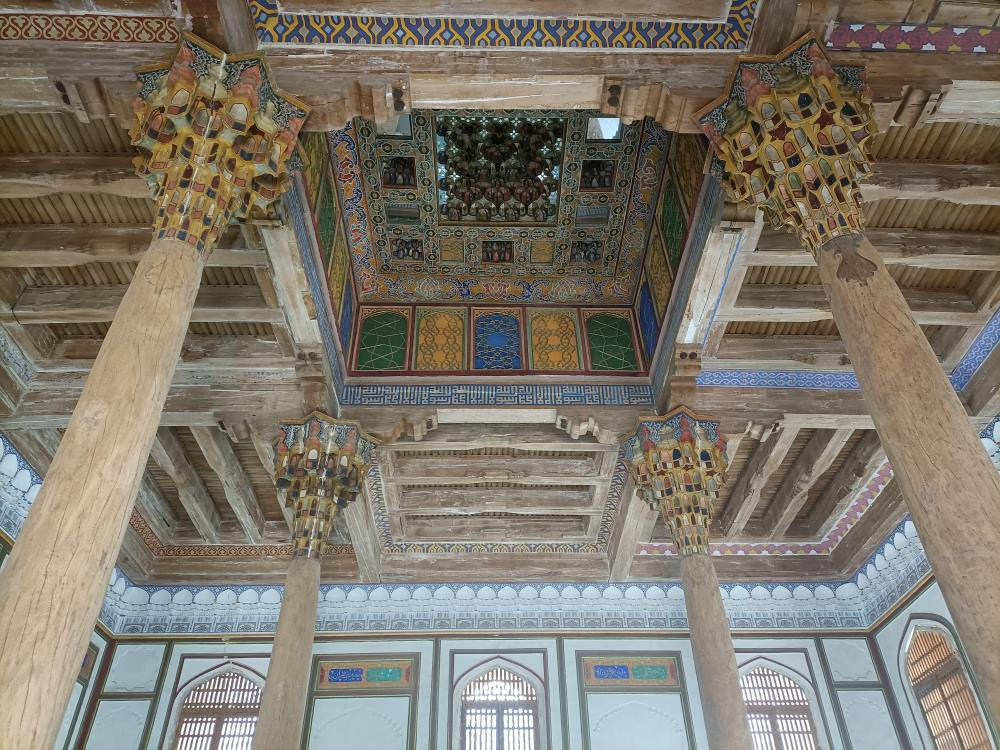
Bukhara Observation Tower
Also known as the Sukhov Observation Tower, this modern structure is visible from the Ark of Bukhara. From the Ark’s parapets, visitors can spot this 33-meter-high tower, originally built as a water tower by Vladimir Sukhov. However, it became obsolete in the 1970s.
The tower was then converted into a restaurant, which was unsuccessful. Eventually, it was repurposed as an observation tower, which it remains today. It offers one of the highest vantage points in Bukhara.
Bukhara Observation Tower timings: 9 am until 8 pm.
Bukhara Observation Tower entrance fee: 40,000 som (US$ 3.5)
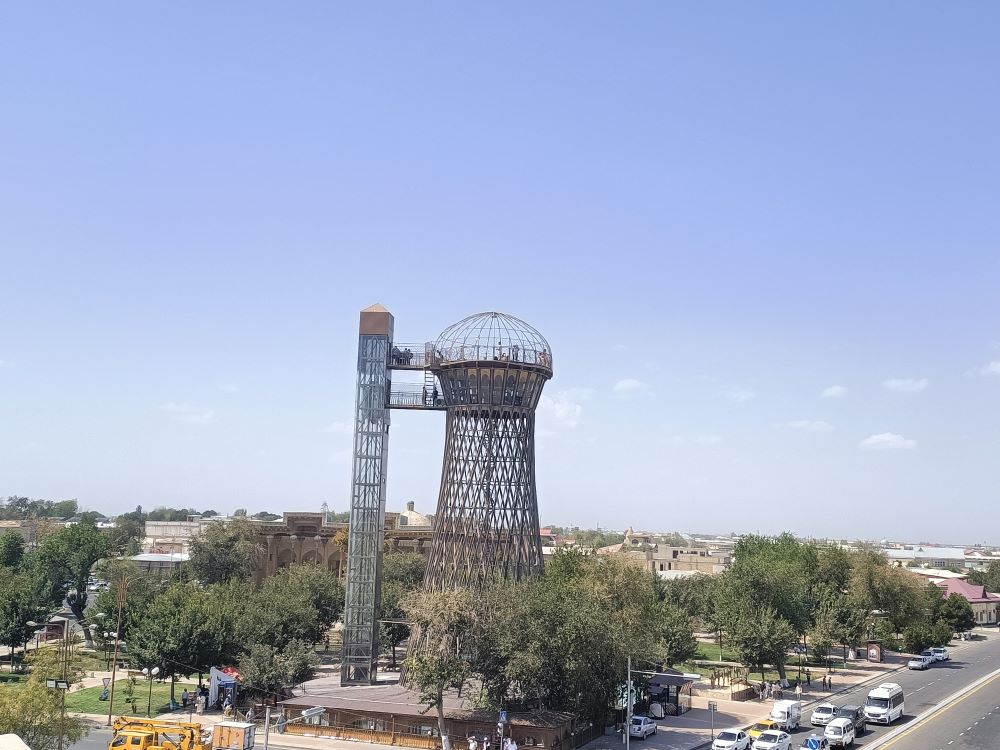
Bolo Hauz Mosque
Just opposite the Ark citadel, lies the Bolo Hauz Mosque. Built in 1712, it has served as a Friday Mosque that allows summer and winter prayers. “Bolo Hauz” translates to “above the pool,” referring to the drinking water pools that once existed in front of the mosque but were filled in during Soviet times to prevent the spread of disease.
Distinct from other mosques, the 18th-century Bolo Hauz Mosque stands elevated on twenty beautifully colored and sculpted wooden columns.
The mosque boasts some of the most stunning and intricately carved wooden pillars you’ll ever see, with a ceiling adorned with gorgeous frescoes and geometric patterns.
Bolo Hauz Mosque timings: 9 am until 6 pm
Bolo Hauz Mosque entrance fee: Free
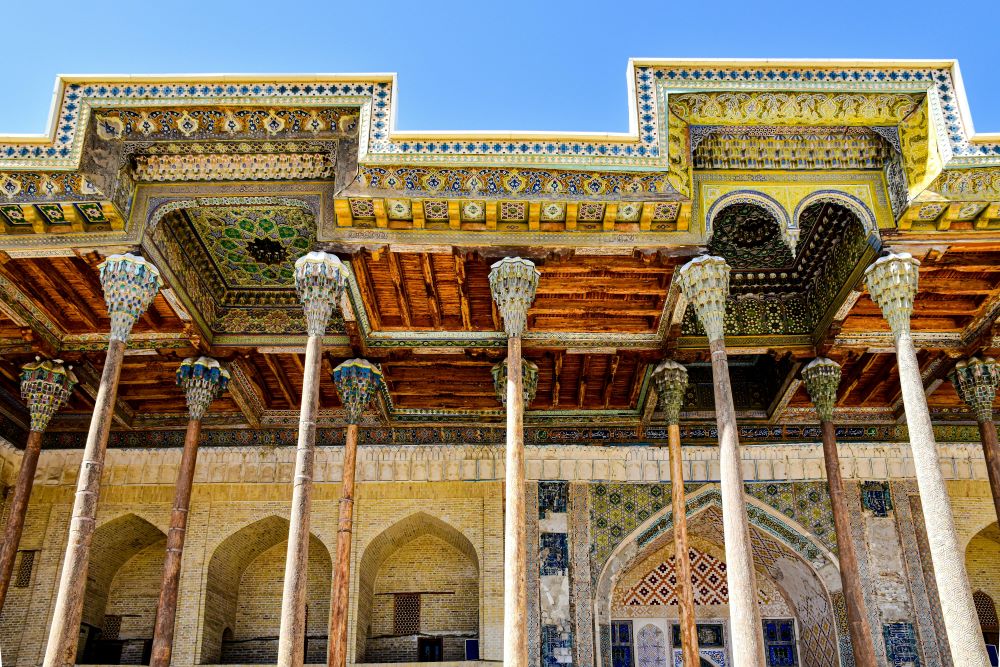
Chor Minor Madrassa
Chor Minor is uniquely situated away from the old city, nestled in the center of a residential area. Despite its considerable height, the building remains hidden from view until you are right next to it.
Meaning “four minarets” in Tajik, Chor Minor is one of Bukhara’s most charming structures, featuring four turquoise domes. These towers were never intended for religious use as minarets; instead, they are believed to symbolize the world’s four religions. Each of the towers is adorned with different motifs. Three were used for storage, while one contains an interior stairwell leading to the top.
Inside Chor Minor, there is a small souvenir shop selling traditional Uzbek handicrafts on the ground floor.
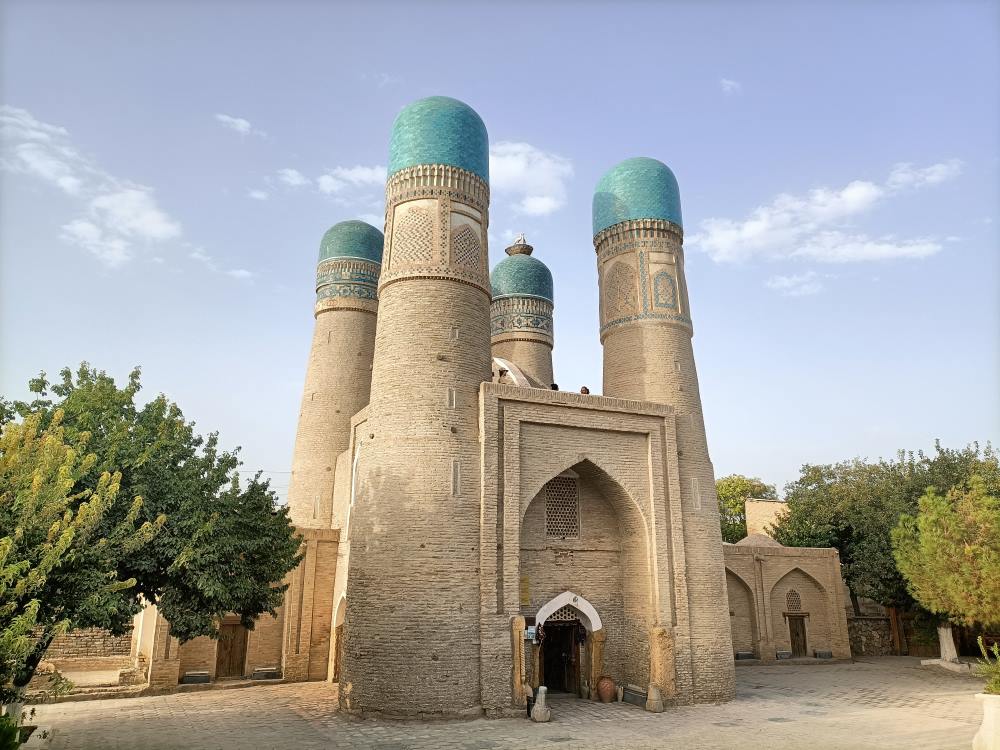
On one of the domes you can see a stork and nest. Bukhara was once known as the city of storks. Over 200 pools throughout the city provided ample food and water, allowing storks to thrive and build nests on rooftops of structures. However, these ponds also became breeding grounds for disease, leading to several epidemics and plagues. When the Bolsheviks took control of the city in the 1920s, they closed almost all the pools and modernized the water system. Without the ponds, the frogs vanished, and consequently, the storks left the city.
But in honour of the birds, there are artificial nests and stork statues put up on many structures across Bukhara with the hope that they will return.
Chor Minor Madrassa timings: 9 am until 6 pm
Chor Minor Madrassa entrance fee: 20,000 som (US$1.5)
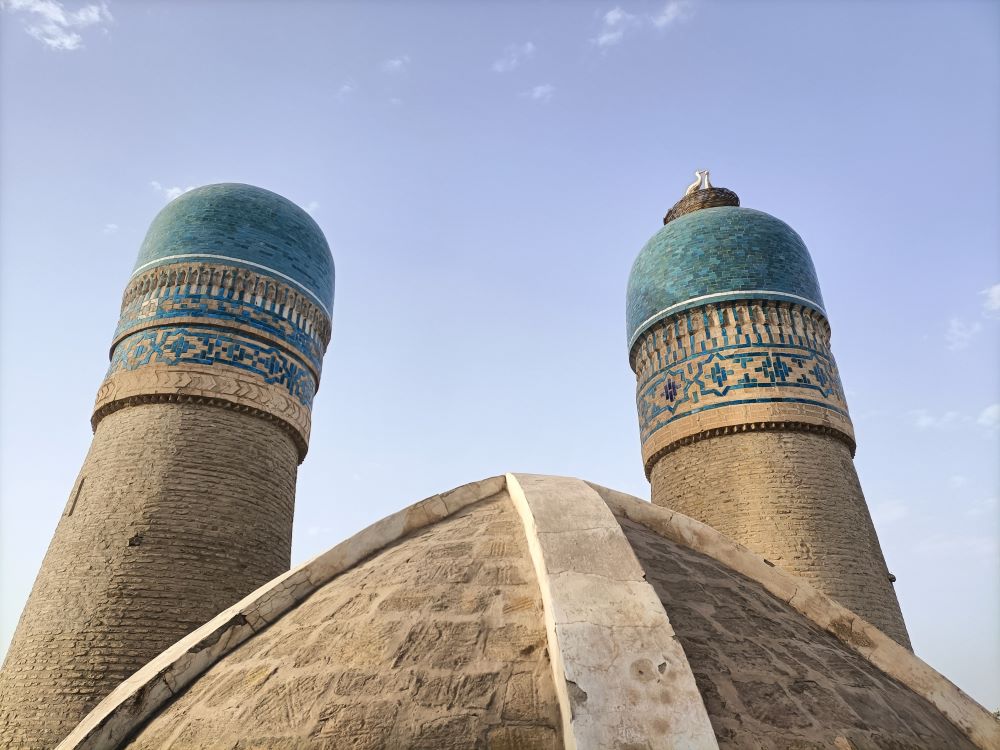
Central Bazaar
Also known as trading domes, these structures were bustling bazaars on the Silk Road. Numerous markets and trading domes in the city allowed traders from Asia and Europe to display their goods. Today, only four such domes remain: Toqi Telpak Furushon, Tim Abdulla Khan Trading Dome, Toqi Sarrofon Bazaar, and Toqi Zargaron Trading Dome. While each trading dome originally specialized in specific items, most now sell carpets, rugs, jewelry, and other souvenirs from Uzbekistan.
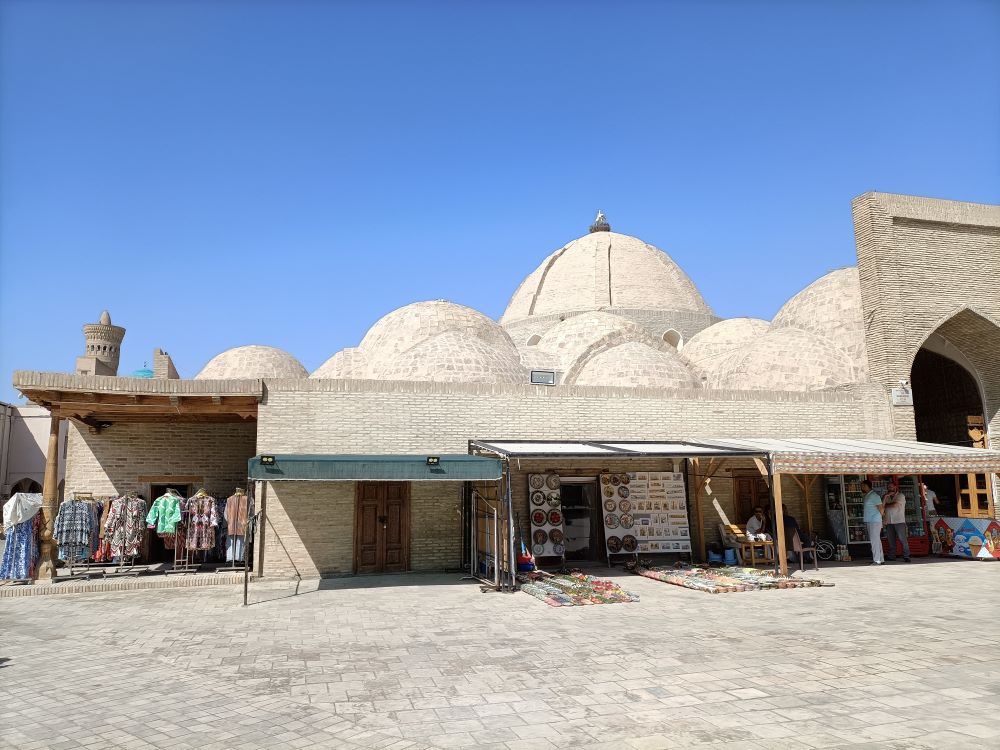
All these trading domes are located around the city center, and you will likely encounter them while exploring the area. One of them is situated right in the center, near the Po-i-Kalyan ensemble.
Here there are carpet workshops, suzani embroidery shop + gallery, ikat garment making gallery + shop that visitors can visit, learn and buy.
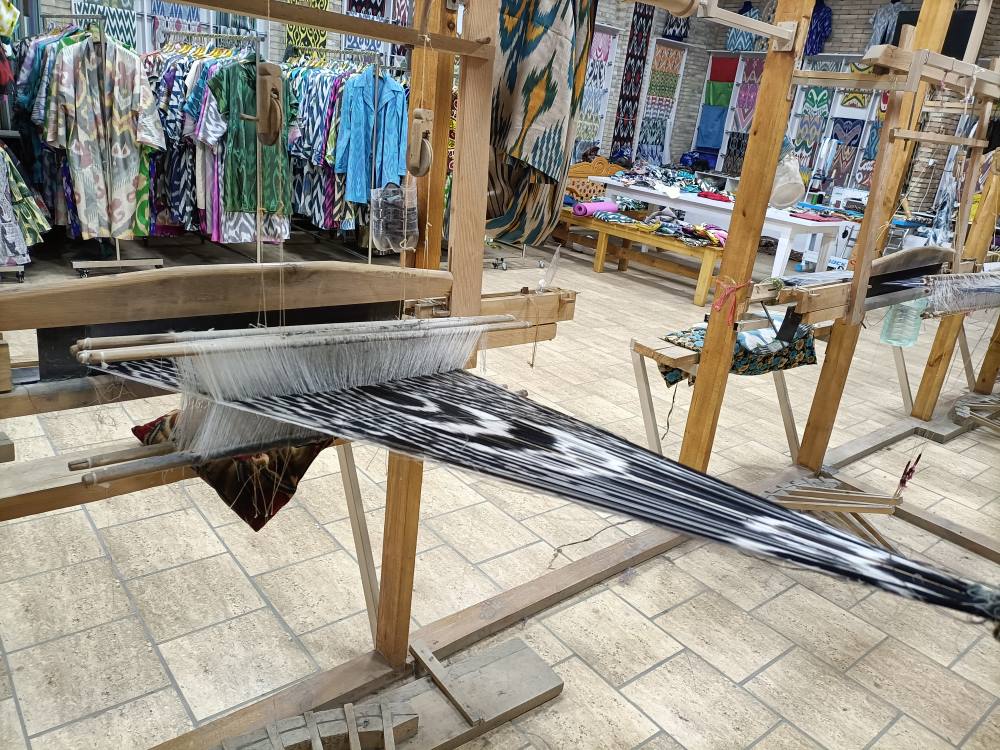
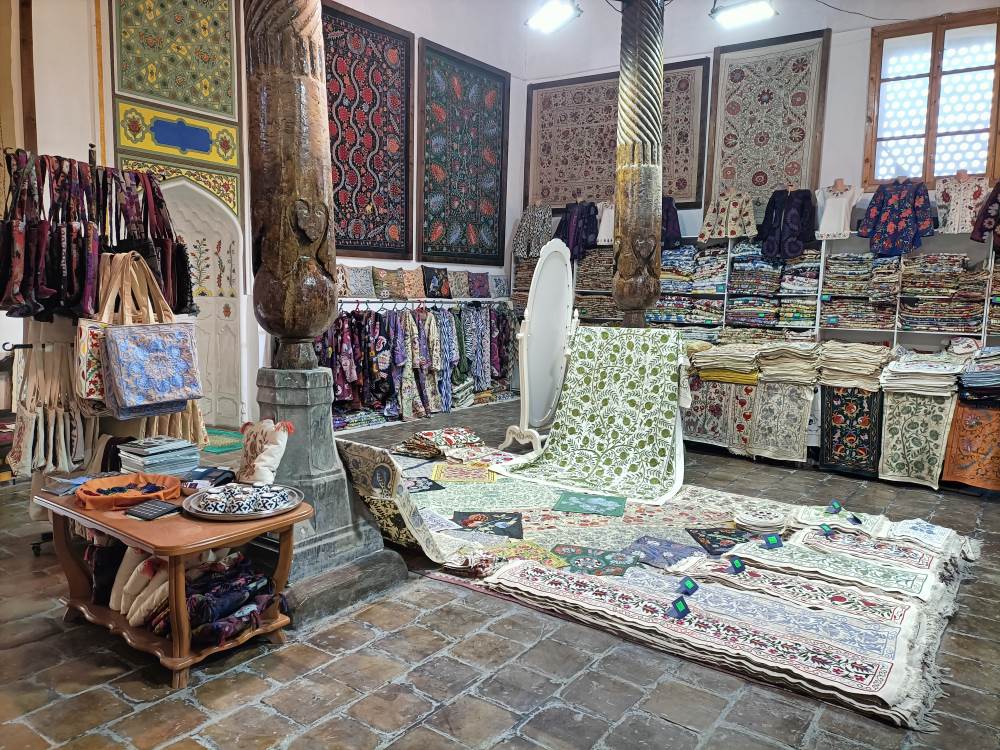
Bozori Kord Bathhouse
Start day two with a visit to a traditional hammam at an Uzbek bathhouse. Experiencing a hammam in Bukhara can be one of the most authentic cultural activities in the city. Bathhouses in Bukhara date back to the 10th century and are mentioned in the writings of Central Asian history. This leisure activity was enjoyed by both the rich and the common people of Bukhara.
Today, only two bath houses remain in Bukhara. The most popular one is Hammam Bozori Kord, built in the 14th century, which continues to be a local hotspot. It is located near the dome of Telpak Furushon and is easy to find. However, Hammam Bozori Kord only has male attendants and masseurs, and it is open only to male tourists.
A little further down the road, there is a bathhouse for women, but it was closed when I visited. A neighbor informed me that you need to call the number provided to make an appointment, as they open after 9 am. However, I decided against it since I had other parts of the city to explore.
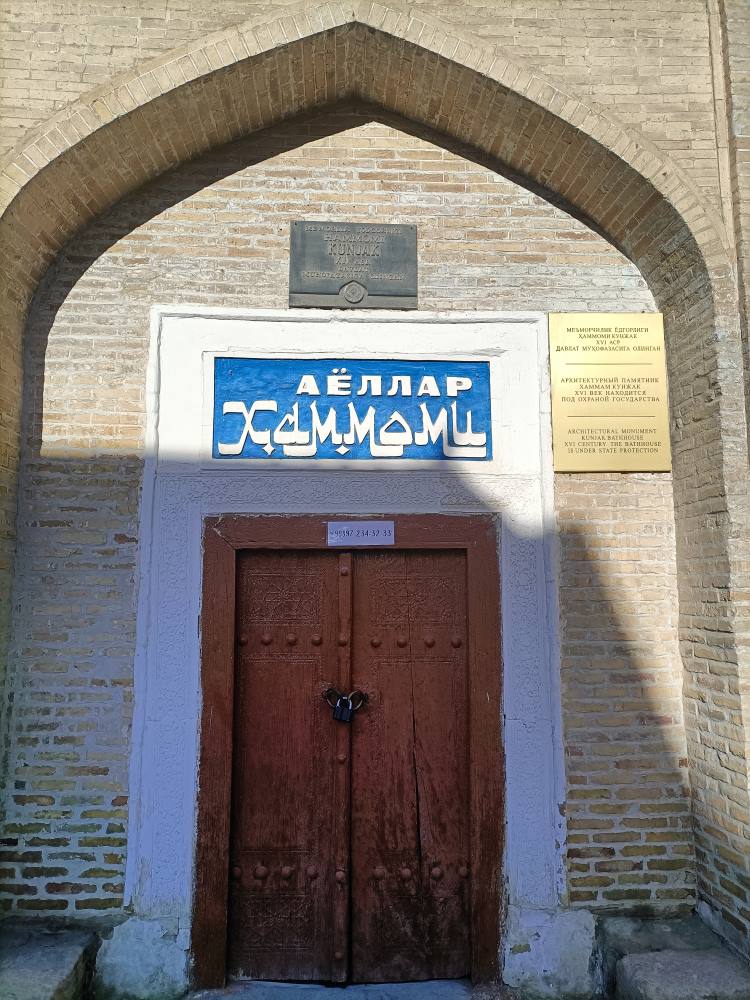
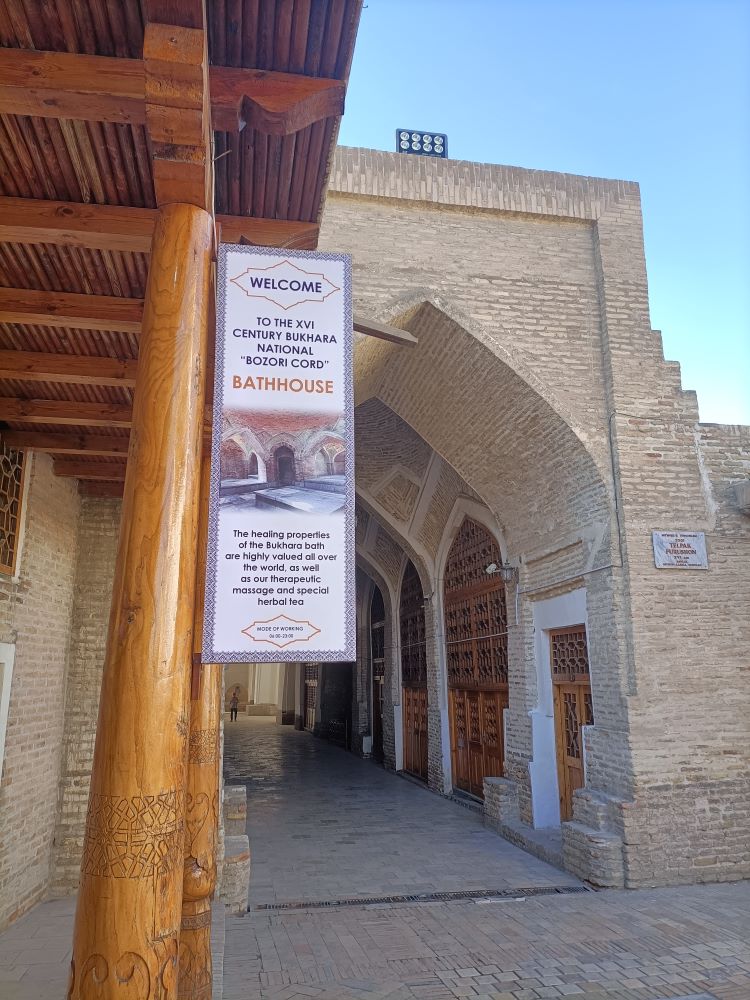
Bukhara Photo Gallery
If you are interested in photography, old cameras or prints of the old city, then the Bukhara Photo Gallery is one of the best places to visit in Bukhara. This private gallery, located in the former Olimjon Caravanserai, showcases the work of Shavkat Boltaev. It features paintings and prints that depict typical Uzbek life, with many beautiful pieces available for purchase. The collection focuses on the daily life and history of Uzbekistan and Bukhara, making it one of the best places to explore in Bukhara for photography enthusiasts.
Lyab-i-Khauz
Lyab-i-Hauz means ”by the pond” in Persian. It’s the name of the area that surrounds one of the few hauz/khauz or small water ponds of Bukhara. A hauz or pond was once used by locals to collect water, but it became unsanitary due to many reasons in the soviet era.
Only a few remain now and Lyab-i-Khauz, with its palm tree-fringed perimeter, provides a popular meeting place for both locals and travelers alike. This open-air area of Lyab-i-Khauz, surrounded by small restaurants, souvenir shops, a very unique madrassah, and a mosque, is just perfect for soaking in the ambience of Bukhara.
Lyab-i-Khauz is quiet during the day but the vibe totally changes by evening with restaurants setting up tables around the pond, live music, dancing and food. Grab a table and order local food or just hand around the periphery enjoying the atmosphere.
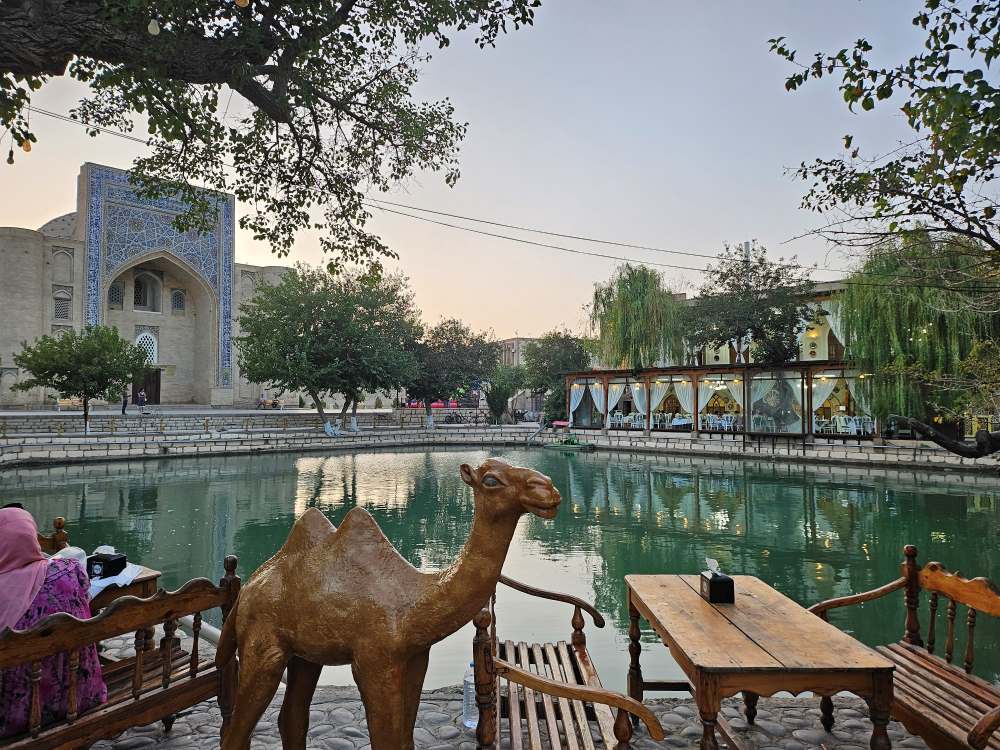
Madrasah Nadir Devon Begi (at Lyab-I-Hauz Ensemble)
This complex is one of three from the 17th century encircling the Lyab-i-Khauz pond. To the east of Lyab-i-Khauz sits the Nadir Devon Begi Madrasah. Its exterior mosaics feature striking depictions of colorful tigers and antelopes, catching the eye of passersby.
As was customary, the internal courtyard of the madrasah housed small handicraft shops within its walls.
In the evenings, a traditional Uzbek dance performance takes place here. Tickets must be purchased to enter and watch the performance.
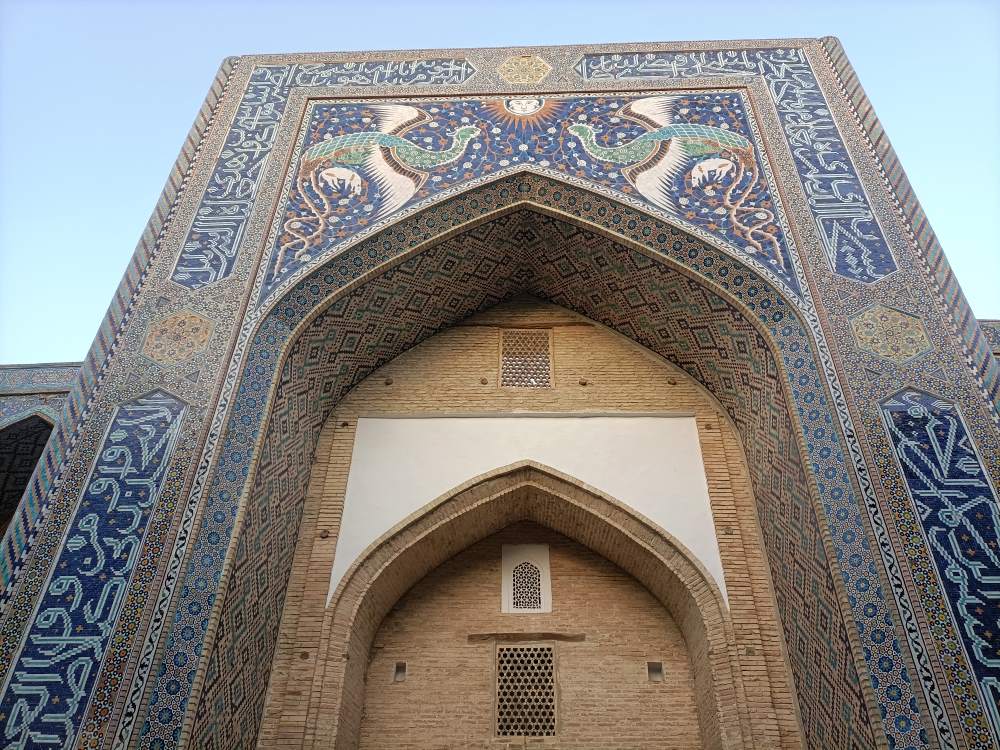
Hodja Nasruddin Statue
Exactly in the front entrance of the Madrasah Nadir Devon Begi, I noticed a continuous crowd of people posing with something. It was behind some bushes and so to get a clearer photo I moved forward to see a very unique statue of a man sitting on a donkey.
Apparently the funny man is the renowned Hodja Nasruddin. Hodja Nasruddin, believed to have been a scholar from the 13th century, was known for traveling extensively to share his life stories and wisdom through humor and wit. He traveled on animals which is why this statue is so apt.
His legend spans across Asia, Africa, and Arabia, sometimes under local variations of his original name.
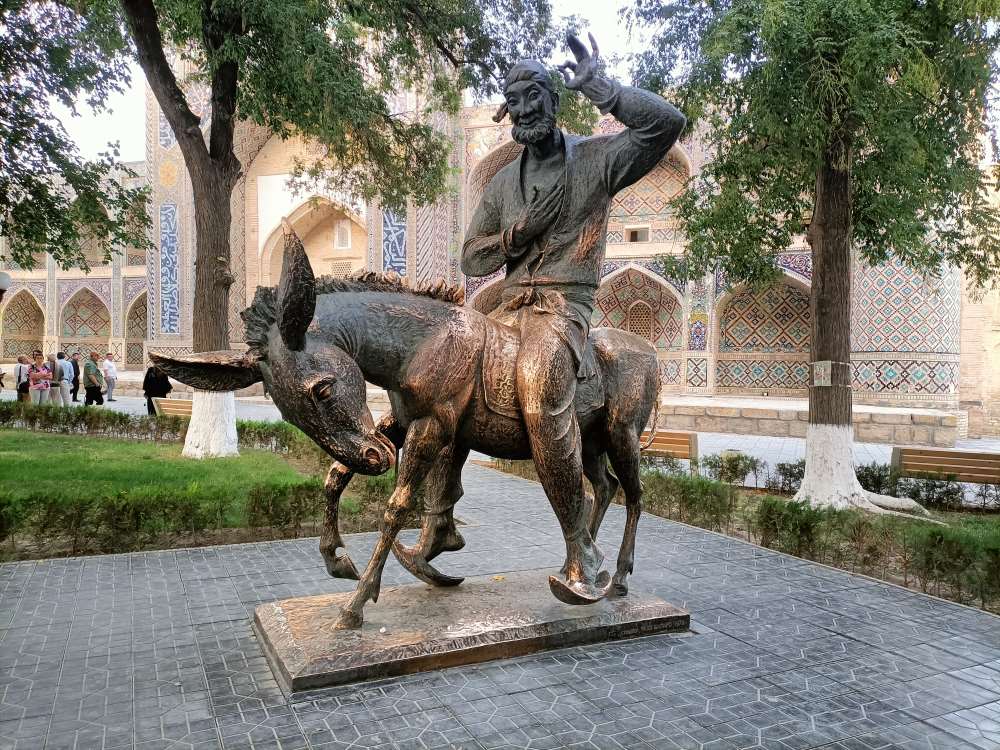
Ulugbek Madrassah
Near the central market is the beautiful Ulugbek Madrassah. Completed in 1417, the portal of the building bears a carved inscription from the Quran: “The pursuit of knowledge is the responsibility of every Muslim man and woman.”
This madrassah is relatively small compared to the ones found in the Po-i-Kalyan Complex but it’s still very beautiful. The individual who commissioned its construction was known as Ulugbek, an enlightened and intellectual ruler deeply invested in the advancement of science in Uzbekistan. During his reign, Bukhara maintained a strict and conservative atmosphere.
Ulugbek made the decision to construct this madrassah with the aspiration of transforming the city into a hub of science and education, steering it away from its conservative nature.
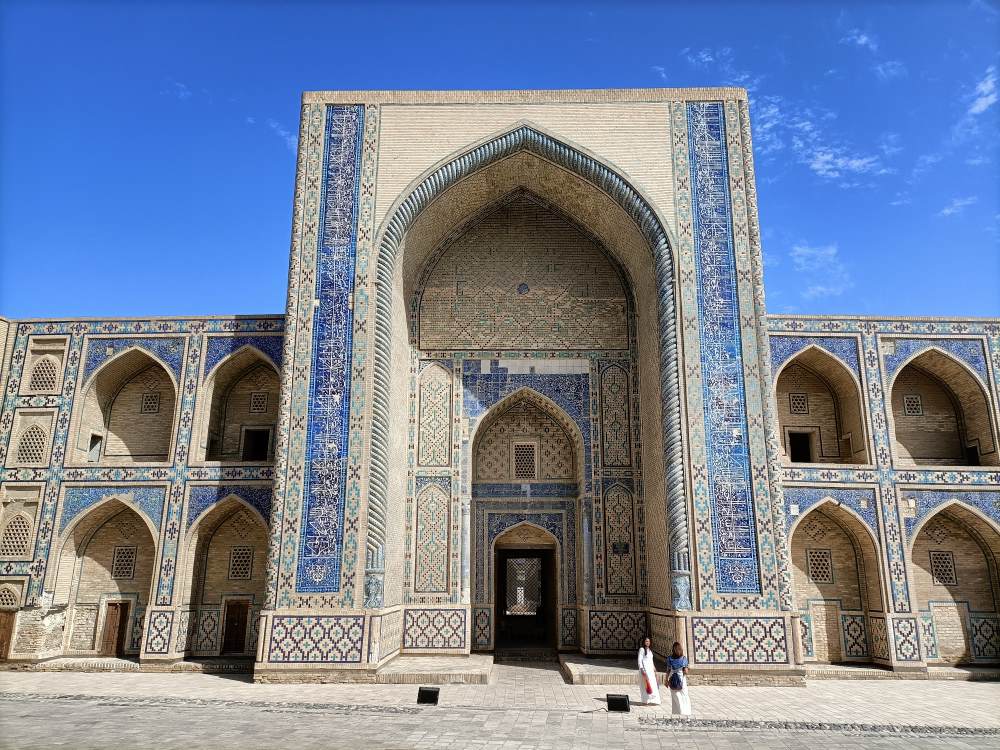
Abdulaziz Khan Madrassah
Abdulaziz Khan Madrassah is part of the architectural ensemble of Ulugbek Madrassah and is found right across from it. However, it is much bigger and more beautiful.
It was built a few centuries after the Ulugbek Madrassah and clearly shows how architecture evolved drastically in the time period between the two constructions.
While the Ulugbek Madrassah is quite simple, the Abdulaziz Khan Madrassah is grand and elaborately decorated. This Madrasah, although modest in size, is decorated with ornate tiles and patterns. The designs are wavy and bright in colours. The walls also have verses of famous poets as well as images of a Chinese dragon and a mythical bird.
Inside the madrasah is a souvenir shop selling all sorts of Uzbek memorabilia.
I spent the evening in a nearby rooftop cafe overlooking Abdulaziz Khan Madrassah and saw a beautiful sunset.
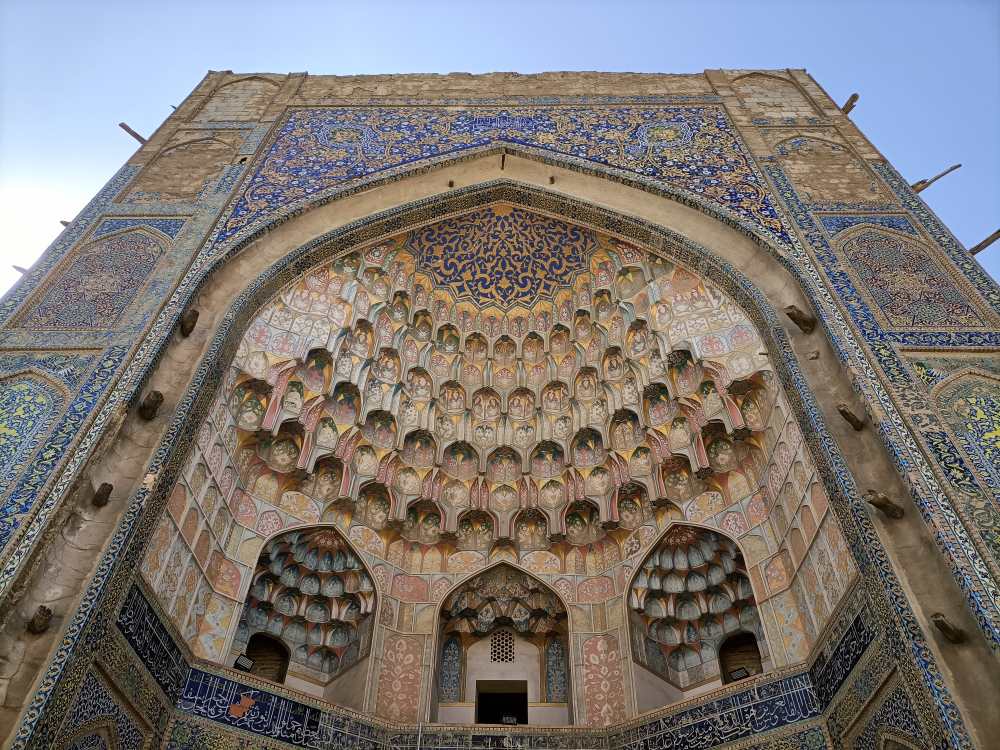
FAQs FOR THINGS TO DO IN BUKHARA
Is a guide required for Bukhara sightseeing?
Bukhara is a UNESCO World Heritage site, and one can understand the history well if there is a guide with you. You can hire local guides at each tourist destination especially at Po-i-Kalyan and Ark of Bukhara who offer services in many languages. Rest of the places do not require a guide.
Is Bukhara safe?
Yes! Bukhara is a very safe city, even if you’re traveling as a solo woman.
The Uzbeks are very friendly and have no bad intentions whatsoever. Be prepared to take loads of photos with locals. Being an Indian, they wanted to strike a conversation with me with the few Hindi words they knew. They are huge Bollywood fans and know many actors’ names.
Best time to visit Bukhara?
Bukhara can be visited all year round but I’d say that early autumn (September and October) and spring (April and May) would be the best time to visit the city.
Summers (June till August) are usually very hot in Uzbekistan. I went in August end and the afternoons were too hot and I am someone who lives in India. It was too much for me as well and I did not venture out between 2-4pm.
Winters (December till February) are also a good time if you want to avoid the crowds. If you’re lucky, you might get to see the stunning architecture coated in snow.
How many days to spend in Bukhara?
1.5 – 2 full days are enough to cover the highlights and the offbeat places in Bukhara.
How to dress in Bukhara?
Uzbekistan is a conservative country so dress appropriately. It gets hot so cover yor skin to avoid sunburn. Mosques require visitors to cover your shoulders and knees and women might have to cover their heads as well.
ATMs in Bukhara
There are plenty of ATMs in Bukhara – both in the newer and older part of the city. You will get Uzbekistan Soms from your Visa or Mastercard. Most hotels and restaurants also accept Visa credit cards / forex cards. Some of them are also willing to accept USD.
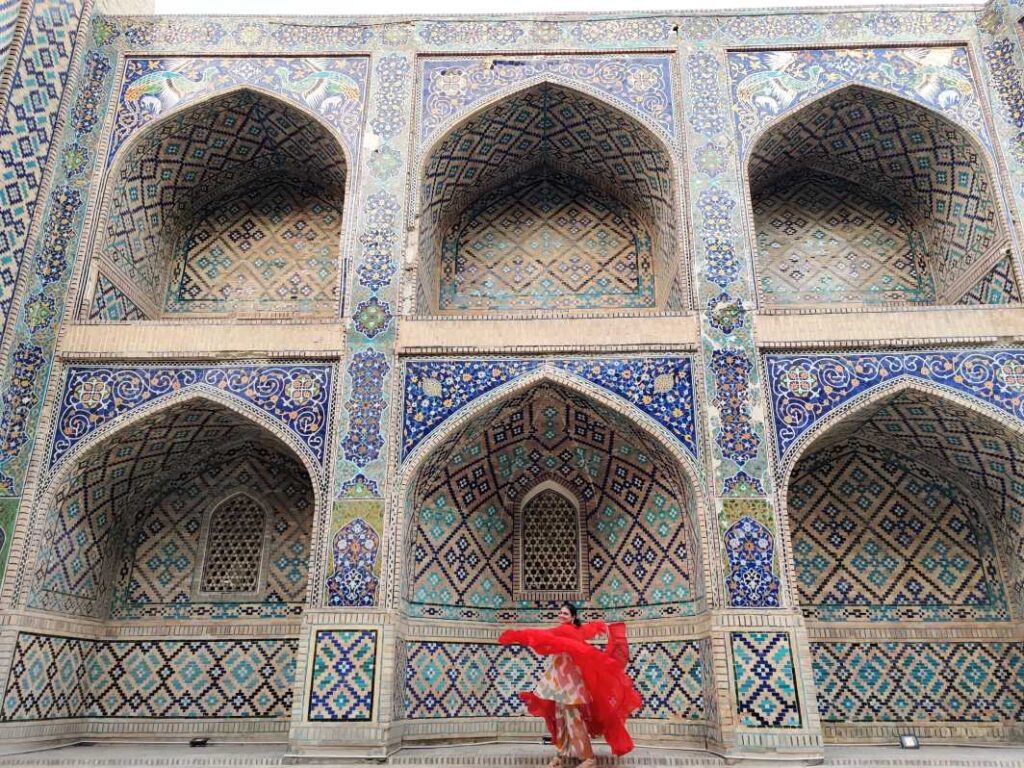
SUSTAINABLE TIPS FOR THINGS TO DO IN BUKHARA
- Carry your own refillable water bottle. Avoid purchasing PET water bottles unless absolutely necessary.
- Do not trash the heritage site with wrappers and uneaten food. Use designated areas and right-colored bins for disposing of waste.
- Be mindful of all the signs and follow them respectfully especially in mosques and mausoleums.
- Respect the ancient structures of mosques and other structures by not sitting on them.
- Respect the places which prohibit photography.
- Do not write on the pillars and walls of archeological sites and monuments.
I hope this 2 days Bukhara travel guide helps you plan all things to do in Bukhara. Do you have more questions? Write to me in the comment below and I will reply.
Looking for more Uzbekistan Inspiration? Read Here
- Things to do in Samarkand
- Uzbekistan Travel Guide
- Tashkent Metro Stations
- Tashkent Attractions
- Souvenirs to buy from Uzbekistan
- Things to do in Khiva
- Vegetarian food in Uzbekistan
- Travelling by train in Uzbekistan
Disclaimer: This post contains affiliate links. It means it adds no extra cost to you if you book through the link but I get a referral bonus which helps me earn a little to keep this website up and running.
PIN THIS POST!
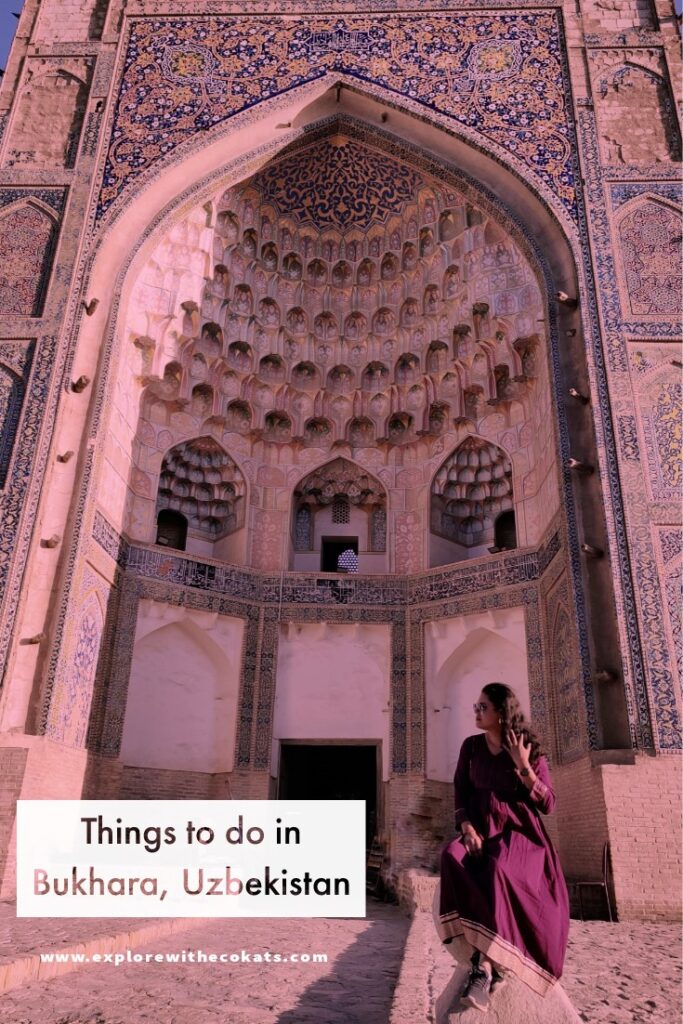
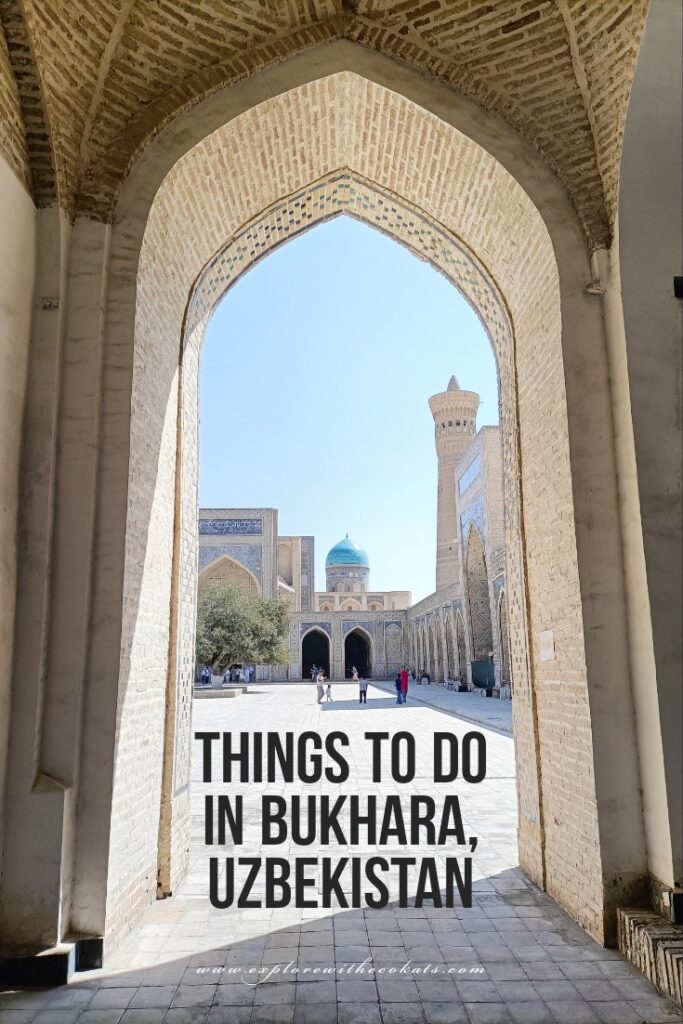

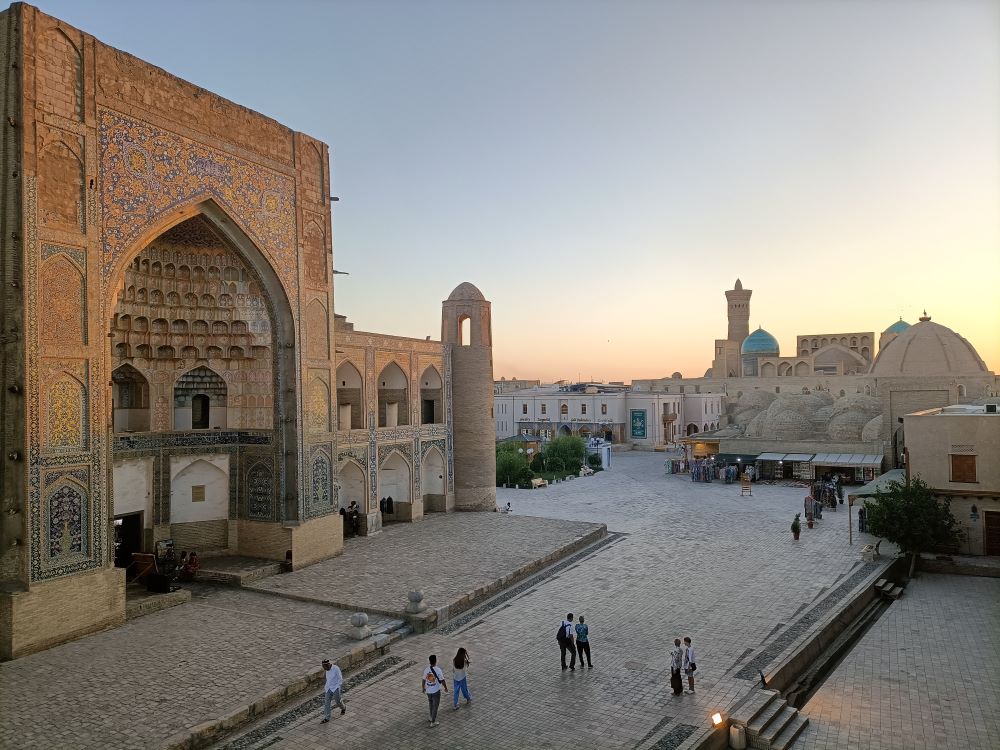
1 comment
Bukhara looks like an amazing destination! The mix of history, culture, and stunning architecture is truly captivating. I’d love to explore the ancient sites and local experiences highlighted in this post!